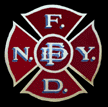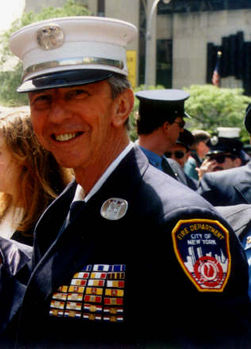 |
 |

|
Frequently asked Fire Fighting questions
If you want to know how to do it right, invite him to come to your Department to set up a program. JJVIG176@aol.com
CAPTAIN JOHN T. VIGIANO John T. Vigiano is a retired Captain of the New York City Fire Department, with over 38 years of service. His career started in 1962 with Ladder Company 103 in the East New York - Brownsville section of Brooklyn. He transferred to Rescue Company 2 for a short period but returned to Ladder 103 until his promotion to Lieutenant in 1976. After a 6-month period of covering in Far Rockaway, he returned to Brooklyn and to Ladder Company 132 where he stayed until his transfer to Rescue Company 2 in 1977. He remained in Rescue Company 2 until his promotion to Captain in 1988. Upon promotion, he was assigned to the Rescue Liaison Unit for nearly a year until his assignment to Ladder Company 176, "The Tin-House Truck" where is he retired as the Company Commander in May of 1998. John is a graduate of John Jay College with a Bachelors Degree in Fire Science. He is also a Certified New York State Instructor who was an Adjunct Instructor to the New York State First Line Supervisors Training Program. He was also an adjunct instructor for the Captains Management - Training Program for the New York City Fire Department. In addition to his full time fire career, John also worked for the Suffolk County Fire Training Academy for over 14 years. Where he designed and wrote the Heavy Rescue Program. He retired from the County in 1998. He has authored many articles for the various trade magazines such as Firehouse, Fire Engineering and Fire Command. He has lectured at the Firehouse Conference in Baltimore in 1998 and FDIC in Indiana this year. John has been lecturing to many departments for over twenty years. He is the director of Fire Mark Consultants; a company that specializes in fire related seminars.
Subject: Accountibility By: Captain John Vigiano (Ret) There is a riding list. The officer on duty writes this up at the start of each tour (shift). It lists the following info: a) Members riding position, eg. where he/she is seated on the apparatus. b) Members assignment, eg. forcible entry, roor, chauffeur, etc. c) Members group #. eg., the assigned group on the units roster d) The SCBA assigned to that member for the tour. This list is approx 3" x 4" and is made out in duplicate. The original is placed on the dash board of the apparatus and the duplicate is carried by the officer. In the event of a disaster (building collapse, flash over, etc) where members are lost or unaccounted for the Inicident Commander will have each officer conduct a roll call to account for his/her members, using his copy of the riding list. This is important, since there are times when the officer does not know the members he/she is working with. It could be an officer just assigned for the tour. If however, the officer is one of the missing, then the list is removed from that members apparatus, and the roll call conducted....hence the two copies.
Subject: Rapid Intervention Crews ( F. A. S. T. TRUCK ) By: Captain John Vigiano (Ret) I was asked to send you some info on Rapid Intervention Crews. Here in NYC, we refer to them as F. A. S. T. units. (firefighter assist search team). Other areas of the New York, the term used is Rapid Intervention Teams. They are all the same and have the same purpose; to aide fire units or fire personnel in trouble. I have recently reitired (May 1998) from the New York City Fire Department. I spent the last 36 years doing what I loved....riding a fire truck and going to fires. A few years ago, the FDNY, went through a tough time. Too many members were injured and killed in a short periord of time. The think tank went into overdrive and soem pretty smart people came up with ideas to curb this problem. Being a firefighter, you know, we can not change fate, but we can make adjustments to training and education to ensure our people have help when they need it. Hence, the F.A.S.T. concept was initiated. Here is a copy of my former units policy concerning the F.A.S.T. TRUCK (Firefighter Assist and Search Team) LADDER COMPANY 176 POLICY This unit is an additional ladder company above the ladder companies assigned on the second alarm. Upon arrival, the FAST truck will report to the Incident Commander at the Command Post; advise the IC that "they are the FAST TRUCK", and follow his direction. As per the AUC 273 addendum #155 and ABC 5-88, all members will be equipped as follows: SCBA WITH PASS ALARMS SEARCH ROPE LIFESAVING ROPE / LIFE BELT RABBIT TOOL WITH FORCIBLE ENTRY TOOLS "NORMAL" TOOL ASSIGNMENT WITH ROOF SAW. GENERAL DUTIES: Listen to HT (Hand held portable radio) transmissions while responding and walking to the CP. Look at the fire conditions, and discuss what you see. Anticipate where we would go and how we would get there....ladders, fire- escapes, breaching a wall....if the situation turns to s_ _ t Take note of the units working ; their unit numbers; they may be re-located units. Check out what apparatus we would place our equipment if call to work as a relief unit or if equipment is not necessary for operation. ANTICIPATE PROBLEMS - HAVE A REACTION PLAN SPECIFIC DUTIES: (Note: FDNY we have a minimum of an Officer and 5 members) A. INSIDE TEAM: ( Officer / Can / Forcible Entry) FIRE ESCAPES: Are they overcrowded ? Will interior units be using them ? Will that be the way to get into the building quickly ? PORTABLE LADDERS: Are they in place ? Are additional ladders necessary ? B CHAUFFEUR: Go to the Aerial / Tower ladder in front of fire building and check it out. Get familiar with the controls, and make sure it is ready to be used. Stay at the turntable if the assigned chauffeur is not there. If assigned chauffeur is there, stay at the pedestal in case the assigned chauffeur is called into the building by his officer. C. OUTSIDE TEAM (OVM / ROOFMAN) Check out the perimeter of the building.... Take note of any shafts, fences or fire-escapes Note any obstacles or problems the unit may encounter. Report back to Unit Officer in front of building or at CP REMEMBER THIS IS A SIZE UP ONLY. ANTICIPATE PROBLEMS - HAVE A REACTION PLAN THIS IS A UNIT OPERATION, NOT AN INDIVIDUAL ONE I trust this will assist you and your department
Subject: The award system the FDNY uses. By: Captain John Vigiano (Ret) I spent over twenty years on the "Appeals Board", which is a board of five staff officers and two line officers; I was one of the line officers. When I retired this past May, I was the most senior member of the department with that experience. Now that I have given you the "commercial", lets see if I can help you out. First off you need some guidelines as to given initial awards. In the FDNY, they had two distinct categories of award: Service Ratings: this was further broken down to: Service Rating "A" involved initiative and bravery. (higher than...) Service Rating "B" which involved initiative or bravery . Class Awards: Class 1 - For Extreme personal risk (highest) Class 2 - For Great personal risk CLass 3 - For Unusual personal risk Unit Citation: When a Unit performs above and beyond its normal function. example; an Engine company stretches a line and puts out a fire. (Normal job description), however, they also raise portable ladders and rescue victims from the fire while streching and putting out the fire.....(an idea of a Unit Citation). Honorable Mention: worthy of recognition, but does not fall under any of the above. How the system works................ When an individual or a unit performs an act worthy of any of the above, a detailed report should be made out by the officer in command of the unit or member and forwarded through channels. The Chief in charge of the operation, should investigate and make a recommendation as to the degree of award; e.g. a service rating or a class act or none of the above. If the CIC feels it is not worthy of any recogition, it is filed. If he does feel it is worthy of recognition, it is forwarded to the Board of Merit. The Board of Merit: A board acomprised of experienced and respected officers, ususally staff officers. Based on the facts presented in the report and the recommendation of the CIC, they will decide the degree of award. This board (Board of Merit) must meet at least quarterly and post its findings at the conclussion of the meeting. Medal Board: This is another board that meets yearly, to decide what Class Awards (1,2 and 3 only) will be awarded a Medal of Valor. The fortunate members picked should receive their medal at a yearly ceremony where their peers and family gather to withness this achievement. Generally the Medals are pinned on the recipient by the Mayor of the City. Medals of Valor: These are designed and struck by a compnay that makes medal. Many are pure gold and most are "other than gold". These medals are usually given to the city by a benefator (corporation or organization such as American Legion, Bell South, etc.) They are all different and usually are in memory of an important event or of a member of the service that died. Many of the medals of valor are accompanied with a cash award for the member receiving it. The higher the medal, the higher the award. They are expensive and should not be given away lightly. That is the system in a nutshell. If your department is serious about this and would like some help setting it up. They can hire me to come to your city and work with your people setting the system up. Since I am retired, I have the time, but they would have to pay my expenses.